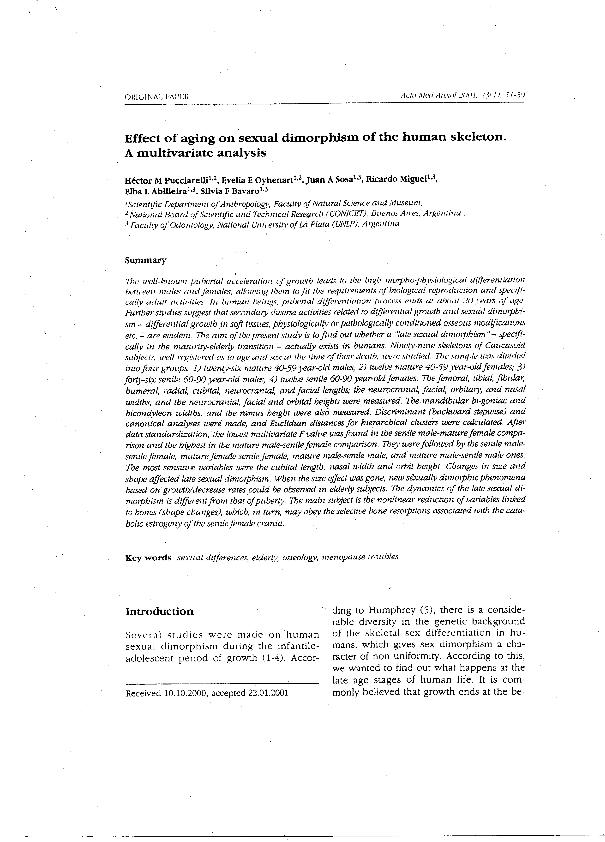Artículo
Effect of aging on sexual dimorphism of the human skeleton: A multivariate analysis
Pucciarelli, Hector Mario ; Oyhenart, Evelia Edith
; Oyhenart, Evelia Edith ; Sosa, Juan A.; Miguel, Ricardo; Abilleira, Elba L.; Bavaro, Silvia Fabiana
; Sosa, Juan A.; Miguel, Ricardo; Abilleira, Elba L.; Bavaro, Silvia Fabiana
 ; Oyhenart, Evelia Edith
; Oyhenart, Evelia Edith ; Sosa, Juan A.; Miguel, Ricardo; Abilleira, Elba L.; Bavaro, Silvia Fabiana
; Sosa, Juan A.; Miguel, Ricardo; Abilleira, Elba L.; Bavaro, Silvia Fabiana
Fecha de publicación:
12/2001
Editorial:
Centro Auxologico Italiano di Piancavallo
Revista:
Acta Medica Auxologica
ISSN:
0001-6004
Idioma:
Inglés
Tipo de recurso:
Artículo publicado
Clasificación temática:
Resumen
The well-known pubertal acceleration of growth leads to the high morpho-physiological differentiation between males and females, allowing them to fit the requirements of biological reproduction and specifically adult activities. In human beings, pubertal differentiation process ends at about 20 years of age. Further studies suggest that secondary diverse activities related to differential growth and sexual dimorphism ?differential growth in soft tissues, physiologically or pathologically conditioned osseous modifications, etc- are evident. The aim of the present study is to find out whether a "late sexual dimorphism" - specifically in the maturity-elderly transition - actually exists in humans. Ninety-nine skeletons of Caucasoid subjects well registered as to age and sex at the time of their death, were studied. The sample was divided into four groups: 1) twenty-six mature 40-59 year-old males; twelve mature 40-59 year-old females; 3) forty-six senile 60-90 year-old males; 4) twelve senile 60-90 year-old females. The femoral, tibial, fibula, radial, cubital, neurocranial, and facial lengths, the neurocranial, facial, orbitary, and nasal widths, ad the neurocranial, facial and orbital heights were measured. Discriminant (backward stepwise) and canonical analysis were made, and Euclidian distances for hierarchical clusters were calculated. After data standardization, the lowest multivariate F-value was found in the senile-mature female comparison and the highest in the mature male-senile female comparison. They were followed by the senile male-senile female, mature female-senile female, mature male-senile male, and mature male-senile male ones. The most sensitive variables were the cubital length, nasal width, and orbit height. Changes in size and shape affected late sexual dimorphism. When the size effect was gone, new sexually dimorphic phenomena based on growth/decrease rates could be observed in elderly subjects. The dynamics of the late sexual dimorphism is different from that of the puberty. The main subject is the non linear reduction of variables linked to bones (shape changes), which, in turn, may obey the selective bone resorptions associated with the catabolic estrogeny of the senile female crania.
Palabras clave:
Sexual Differences
,
Elderly
,
Osteology
,
Menopause Troubles
Archivos asociados
Licencia
Identificadores
Colecciones
Articulos(IGEVET)
Articulos de INST.DE GENETICA VET ING FERNANDO NOEL DULOUT
Articulos de INST.DE GENETICA VET ING FERNANDO NOEL DULOUT
Citación
Pucciarelli, Hector Mario; Oyhenart, Evelia Edith; Sosa, Juan A.; Miguel, Ricardo; Abilleira, Elba L.; et al.; Effect of aging on sexual dimorphism of the human skeleton: A multivariate analysis; Centro Auxologico Italiano di Piancavallo; Acta Medica Auxologica; 33; 12-2001; 51-59
Compartir



